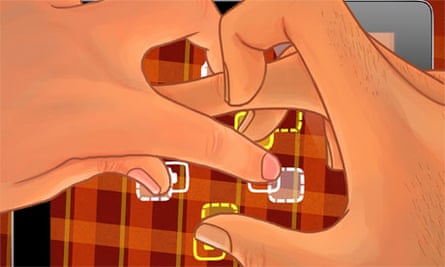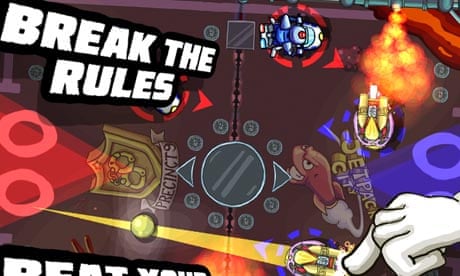"Rule-breaking is creative," Alistair Aitcheson says in his presentation to the audience at GameHorizon. "Laughter trumps fairness." It's this theory of schadenfreude he has come to the conference to discuss: how pitting us against each other can strengthen friendships, and bring players of games closer.
Aitcheson is a one-man indie studio, a first class mathematics graduate who has spent the past three years running his business as an entirely one-man enterprise. Mainly focusing on iOS games, he launched Greedy Bankers onto the App Store in February 2011. The game gets you to group gems into squares and rectangles to maximise your use of space and revenue. You tap them to cash them in. It's a simple, fun idea that sold well.
But talking at GameHorizon in Newcastle last week, Aitcheson explained that when he added multiplayer mode to the iPad exclusive version – and encouraged players to cheat and steal from each other – he started to see the potential of the iPad as a social linchpin. The stealing mechanic became a big deal in his game design. Stealing is incentivised – when you invade other players' space, the other player matters; they become important as part of the game. On several occasions, Aitcheson has seen this descend into a playful wrestling match between friends.
What he had stumbled upon was the fact that so-called "social games" are only meaningful if they are designed purely to bring people together. The idea that players "might get in each others' way" was the key to his thinking: instead of seeing this as a downside, Aitcheson used it as a reason to bring people closer to each other, to have people want to touch each other, get used to each other, and talk to each other.
So Aitcheson decided to take this idea further on the iPad. Slamjet Stadium is a shared screen multiplayer game with a futuristic deathball theme. It received a gold award from Pocket Gamer and was "new and noteworthy" on the Apple store in 61 countries. Another simple idea: grab a character with your finger, launch it to hit the ball into the opposing team's goal. He took it to lots of live events for testing – GameCity, the pub, places where people would gather to socialise anyway. To leverage the social atmosphere, the game was made even simpler to get into – there were no puzzle mechanics to learn, and it was designed for more varied movement across the pad.
Shaping Aitcheson's beliefs about what Slamjet Stadium should be was his opinion that something has been lost by video games' recent lack of local interaction. Today we think of multiplayer as online multiplayer, and often DRM and always-connected games have fought off local multiplayer modes. The days of Goldeneye 64 splitscreen have been eclipsed by so-called "Facebook" games, where the word 'social' has been co-opted to mean a way in which you guilt and bait your friends into participating in a monetising ploy. Platforms have been closed by large corporations looking to make games exclusive to their brand, and people as a consequence have been digitally separated from each other into lonely bedrooms.
Aitcheson wanted to encourage people to play together again. He emphasised physical multiplayer – sharing a tablet screen. Physical disconnection, he said, was OK for matching people together in skill-based games such as Street Fighter IV, however the social aspect is really important. Touchscreens are big interactive canvases; they offer us a bright, enjoyable future in terms of being together, being... well, social.
He is not the only one who thinks this way. GameOven's Fingle and Anna Anthropy's Chicanery (which has been ported to iPad by Bennett Foddy) both look at using the surface space of the iPad to encourage friends to be tactile with each other in a playful manner.

In Fingle, two players must affix their fingers to spots on the iPad that constantly move, forcing players to have their fingers intertwine and touch. It is rhythmic and tactile, and though the music makes the experience slightly ironic (a deep voice groans congratulations whilst the soundtrack is reminiscent of cheesy 70s porn) it's hard not to grin at yourself.
In Chicanery, each player puts their finger on a corner of the screen and has to hold it for as long as they can. If they let go, their character gets their head chopped off – so the real game is trying to push or laugh or even goad each other into letting go. This creates an infinite space in which to play, house rules can be instituted, and anarchy ensues. The real game design here is in making a rule that opens up a space where there is a lack of rules – sort of like the video game equivalent of an unsupervised roller disco: the only rule is that you use the space to make something happen.

Sleeping Beast Games's iOS title, Spaceteam, also comes to mind as an anarchic influence as Aitcheson moves on with his talk. He refers to it as "a co-operative party game for two to four players who shout technobabble at each other until their ship explodes". The game doesn't so much ask players to use physical space to annoy each other; instead, it's their voices as they shout instructions to flip the "Clip-jawed Fluxtrunions" on another player's screen. And instead of physical boisterousness, flat-out ecstatic yelling takes place. Unlike Aitcheson's game, Spaceteam maximises on the fundamental inability of a player to comprehend four instructions being bellowed at once. Once I tried yelling my instructions in a much higher, squeakier voice than my team-mates – and they were much more likely to be obeyed. It took some experimentation, but I annoyed them into submission.
All these games explore personal space, which is something other video games have largely either forgotten about or have abandoned until now. Players are part of the play-space, and though these examples share more of their origins in boardgames than most other video games, the portability and ease of these iPad titles in particular bring a whole new dimension to group dynamics. They can be played anywhere, and used to create shared stories and memories, and encourage interpersonal bonding. Real-world creativity is encouraged in environments not usually reserved for the light fantastic.
To construct these games, Aitcheson explained, you just need to register how many points a player scores. The relic of controllers is not an issue – you get freedom of movement around the board without having to heft around clunky peripherals. With Slamjet Stadium, there is no referee. Creative cheating is encouraged, like in Chicanery: Alistair decided, for example, not to award points for own goals, and gave you an opportunity to block goals, but it was too complex an idea and decided to give the players free rein instead. It helped to keep the flow up. Leaving the player to make up their own rules extends the play – and invites the construction of on-the-fly rules between players. The game becomes self-policing. To extend that idea further, the loading screen on Slamjet Stadium says "It's not cheating if you don't get caught". Through schadenfreude, gloating and the making of underdogs, expression in players is encouraged.
The process of designn that Slamjet Stadium went through was shaped in particular by Aitcheson's experience with his previous game. In the multiplayer version of Greedy Bankers, you could effectively bully your way to victory by focusing on the centre line where bricks cross. However, to open up the space, Slamjet Stadium allows many routes of access across the screen through the use of a ball. There is never a point where both players are focusing on only one thing: the game becomes a flurry of taps and shoves, and movement happens not only on screen but off screen too.
Balance is important to games. But make it deliberately unfair in a social setting and there are a lot more moments of anger, laughter, volume and excitement. Real-world creativity counters game-world imbalance. In Slamjet, Aitcheson says, there is a button in the centre that if you hit on time then it's a free goal – it's a completely unfair mechanic but it changes pacing and becomes more frantic, creating memorable moments where play switches. It's a place where, when the switch happens, you spill your pint over the person next to you, yell at the ceiling, and attempt to kick the other person under the table.
The current proliferation and easy distribution of tablets makes them stand out as a platform for truly social video games – there are no special controllers, and no bulky extra kit is needed such as with boardgames. Perhaps through designers like Aitcheson, iPad games will become the primary way in which laughter will overcome the rigid complex rule systems video games are so known for, and open up a space that has long been the preserve of faceless multiplayer. As he says, "laughter trumps fairness". Perhaps in future, laughter may also come to eclipse the long-embedded stern, serious experience we get playing Call of Duty with internet strangers.

Comments (…)
Sign in or create your Guardian account to join the discussion